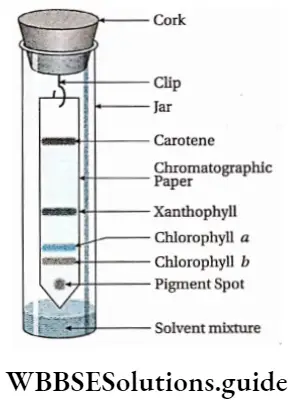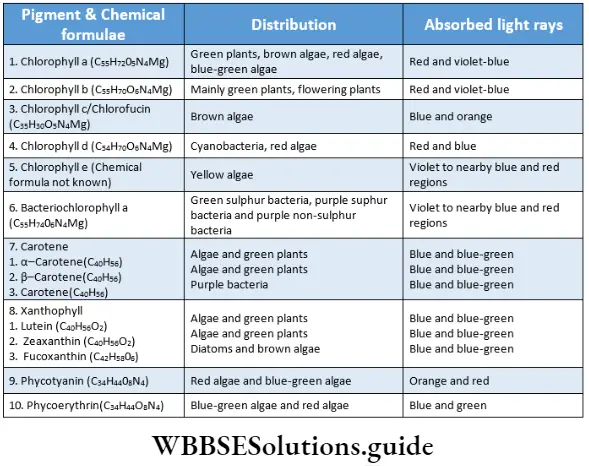Chlorophyll
Chlorophyll Definition: The green-coloured, primary photosynthetic pigment, present in the green leaves, that traps the sun’s rays during photosynthesis, is known as chlorophyll.
Chlorophyll Distribution: It is found in the thylakoid and stroma lamellae of chloroplast in green plants.
Chlorophyll Types: There are five types of chlorophyll present in green plants. These are—chlorophyll a, chlorophyll b, chlorophyll c, chlorophyll d and chlorophyll e. In higher plants, mainly chlorophyll a and chlorophyll b are present. Two types of chlorophyll are seen in the bacteria— bacteriochlorophyll and bacterioviridin (also known as chromium chlorophyll).
Chlorophyll Chemical Formulae
- Chlorophyll a—C55H72O5N4Mg
- Chlorophyll b-C55H70O6N4Mg
- Bacteriochlorophyll—C55H74O6N4Mg
Chlorophyll Characteristics:
- The chemical structure of chlorophyll a and b are well established. They are porphyrin compounds containing magnesium at the centre.
- The porphyrin consists of four pyrrole rings joined by -CH bridges. In addition to it, a fifth isocyclic ring is also present.
- Each pyrrole ring is made up of 4 carbon and 1 nitrogen atom.
- The carbon atoms present towards the periphery of the pyrrole ring are numbered C1-C8. The Cl, C3, C5 and C8 have methyl groups attached to them.
- A long chain of C and H atoms called the phytol chain or phytol tail is attached to the fourth pyrrole ring.
- Chlorophyll b has a slightly different structure. It has – CHO group attached to the third carbon of the pyrrole ring.
Chlorophyll Functions:
- Chlorophyll is the main photosynthetic pigment to absorb light energy. Accessory photosynthetic pigments absorb the energy of a particular wavelength of light and transmit the energy to chlorophyll a molecule.
- P700> P680 function as reaction centres within chlorophyll a. These are regions containing pigments that absorb light of wavelength 700 nm and 680 nm, respectively. The solar energy is converted to electrical energy within these reaction centres, during photosynthesis.
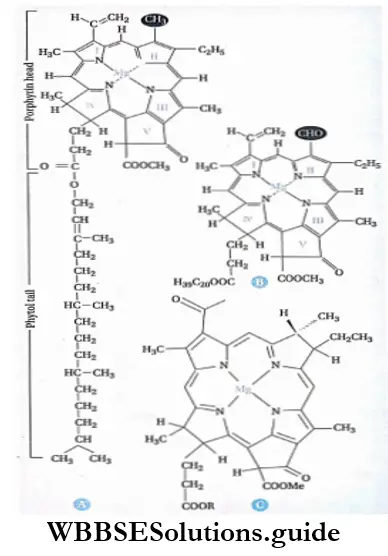
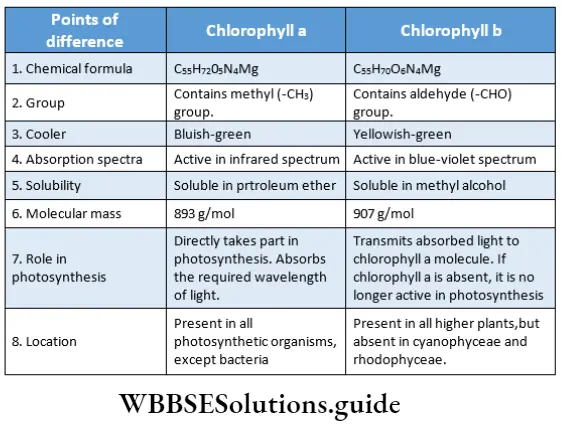
Albino Plant
Chlorophyll is synthesised in plants due to the presence of a specific gene within their chromosomes. In some plants, this gene may be absent and chlorophyll synthesis is prevented. Such plants are known as albino plants.
Carotenoids
Carotenoids Definition: The red or yellow coloured pigments, that act as the accessory pigments are called carotenoids
Carotenoids Types: Carotenoids are of two types—
- Carotenes and
- Xanthophylls.
Carotenoids Distribution: They are present either conjugated with chlorophyll, in -the chloroplastid or present separately within the chromoplastid.
Chemical formula: Carotene (C4H56), Xanthophyll (C4H56O2).
Carotenoids Characteristics:
- All the carotenoids are tetraterpenoids. Carotenes contain long hydrocarbon chains and their oxygen derivatives are called xanthophylls.
- Generally, carotenoids are yellow or orange in colour. They can absorb light of wavelength ranging from 400 to 500 nm.
- Carotenoids are insoluble in water but soluble in chloroform, ethyl ether and alcohol.
- The major carotene in higher plants is yS-carotene with a small amount of or-carotene. The special carotene, responsible for the red colour of tomatoes, watermelon, etc., is known as lycopene.
- The major xanthophylls found in higher plants are lutein, violaxanthin and neoxanthin.
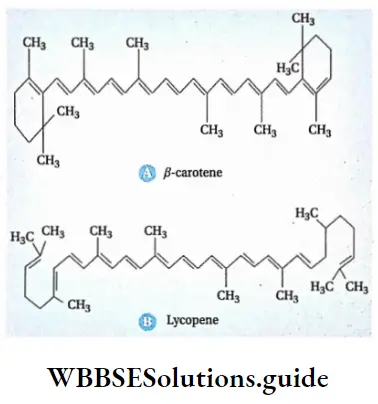
Carotenoids Functions:
- Carotenoids protect the chlorophyll against the photodynamic action of light andO2 (destruction due to light, in the presence of O2).
- Carotenoids act as accessory pigments in photosynthesis. They absorb and transfer radiant energy to chlorophyll during photosynthesis.
- They provide colour to flowers and fruits.
- β-carotene acts as the precursor of vitamin A.
Phycobilins
Phycobilins Definition: The proteinaceous pigments of blue-green algae and red algae that indirectly take part in photosynthesis are called phycobilins.
Phycobilins Types: Phycobilins are generally of three types— phycocyanin, phycoerythrin and allophycocyanin.
Phycobilins Location: These pigments are found attached to the chloroplast lamellae of algae, as small granules called phycobilisomes. Phycocyanin is found in blue-green algae while phycoerythrin is found in red algae.
Phycobilins Chemical formulae: Phycocyanin (C34H4408N4), phycoerythrin (C34H4608N4).
Phycobilins Characteristics:
- These pigments are water-soluble open-chain tetrapyrroles without magnesium at the centre. They also do not possess any phytol tail
- They remain conjugated with a protein molecule, hence called phycobiliproteins.
- The pigment phytochrome of higher plants, which is involved in light absorption for flowering and seed germination, is chemically similar to phycobilins.
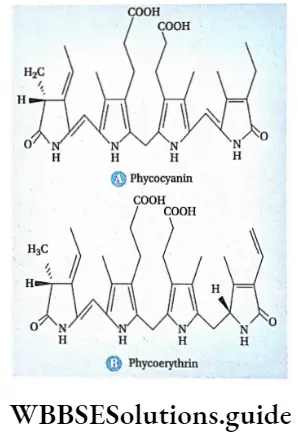
Phycobilins Functions:
- Phycobilins absorb light during photosynthesis and may be regarded as accessory pigments. The light absorbed by the phycobiliproteins is transferred to chlorophyll during photosynthesis.
- These pigments help in chromatic adaptation in plants.
- They also function as antennae molecules
Separation Of Chloroplast Pigment By Paper Chromatography
- Some fresh green spinach leaves were ground in 15-20 ml of acetone with the help of a mortar and pestle. The green-coloured extract was filtered and concentrated by evaporation of acetone. It was used as a sample containing photosynthetic pigment.
- A narrow glass jar with a split cork was taken. A strip of chromatographic paper was cut (narrower and shorter than the glass jar). Two lateral notches were cut at one end of the paper (at a little distance from each other).
- The sample was poured drop by drop over the notched area. A mixture of 92% petroleum ether and 8% acetone was left at the bottom of the jar.
- The chromatographic paper was suspended in the jar by a hook in such a way, that the notched area remained well above the solvent mixture while the other end dipped in it. The set-up was allowed to stand for a few hours.
- After a few hours, the solvent moved up the chromatographic paper.
- The pigment got dissolved in the solvent and ascended to various heights on the paper.
- Four pigment bands are observed over the paper strip in the following order from top to base orange, yellow, blue-green and green.
- Leaves contain four types of photosynthetic pigments. They separate over the chromatographic paper on the basis of their solubility and rate of diffusion.
- The four pigments are carotene (orange), xanthophyll (yellow), chlorophyll a (blue-green) and chlorophyll b (green).
